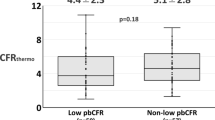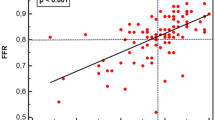Abstract
Coronary flow velocity reserve (CFVR) measurement using intracoronary Doppler techniques has been increasing accepted for the assessment of physiological significance of epicardial stenosis and the functional changes after coronary interventions. However, large discrepancy exists concerning the acute changes of CFVR immediately after intervention. The purpose of this study was to investigate the prevalence of microvascular dysfunction in patients with significant coronary artery disease.
Intracoronary Doppler flow measurements were performed in a total of 212 patients who underwent coronary interventions because of significant epicardial stenosis using 0.014″ Doppler flow wire (Cardiometrics, Inc, Mountain View, CA). Intracoronary bolus injection of adenosine (12 μg for the right coronary and 18 μg for the left coronary arteries) was used to induce hyperemic reaction. CFVR was registered as the ratio of average peak velocity during hyperemia (hAPV) to at baseline (bAPV). Successful coronary interventions either by percutaneous transluminal coronary balloon angioplasty (PTCA) or by stenting could significantly improve the CFVR. In 80 patients with PTCA, the bAPV elevated from 16.6±2.1 cm/s to 20.6±13.4 cm/s and hAPV from 30.1±15.9 cm/s to 45.2±17.7 cm/s (both p<0.001) with PTCA and the CFVR increased from 1.94±0.78 to 2.58±0.87 correspondingly (p<0.001). Significant elevation of coronary flow parameters were also found in 132 patients with subsequent stent implantation (bAPV from 15.3±6.7 cm/s to 18.7±9.1 cm/s, hAPV from 28.7±14.4 cm/s to 44.3±17.7 cm/s and CFVR from 1.90±0.70 to 2.59±0.87, all p<0.001). Reduction of CFVR (<3.0) after intervention still existed in 46 (61.3%) of 80 patients after PTCA and 88 (66.7%) of 132 patients after stenting. Moreover, CFVR<3.0 were found in 50 (45.9%) of 109 reference vessels in patients with single vessel disease.
Significant improvement of coronary flow velocity and coronary flow velocity reserve could be obtained after successful angioplasty. However, microvascular dysfunction existed in a large proportion of patients either in normal reference vessels or in target vessels after interventions.
Zusammenfassung
Eine koronare Angioplastie mittels PTCA oder PTCA und nachfolgender Stentimplantation kann die koronare Flußreserve signifikant verbessern. Im Vergleich zwischen alleiniger PTCA und PTCA mit Stentimplantation konnte eine deutlichere Verbesserung der CFVR durch die PTCA mit nachfolgender Stentimplantation erreicht werden. Dieses beruht mehr auf Zunahme der hAPV als auf einer Veränderung der bAPV. Während bei der Mehrzahl der Patienten eine Verbesserung der CFVR gefunden wurde (80,3% der Patienten nach PTCA und 80,9% der Patienten nach konsekutiver Stentimplantation), konnte bei 2,8% der Patienten nach PTCA und 5,2% der Patienten nach Stentimplantation keine Veränderung der CFVR festgestellt werden, während es bei 16,9% der Patienten nach PTCA und 13,9% der Patienten nach Stentimplantation sogar zu einer Abnahme der CFVR kam. Hervorzuheben ist, daß die CFVR im Zielgefäß auch nach erfolgreicher Angioplastie unter der des Referenzgefäßes lag. Eine mikrovaskuläre Dysfunktion besteht bei einer großes lag. Eine mikrovaskuläre Dysfunktion besteht bei einer großen Anzahl der Patienten auch nach PTCA (61,3% und nach Stentimplantation 66,7%). Mit anderen Worten wurde eine Normalisierung der koronaren Flußreserve nur bei einem Drittel der Patienten mit adäquatem Lumengewinn erreicht. Die anhaltende Steigerung des Ruheblutflusses nach Intervention spielt bei der länger dauernden Verschlechterung der koronaren Flußreserve nach Intervention eine wichtige Rolle. Durch die Veränderung des Ruheblutflusses wird der Quotient zwischen hyperämischer APV und APV unter Ruhe dementsprechend beeinflußt. Andere mögliche Mechanismen sind mikrovaskuläre Spasmen, Mikroembolisationen, Mikroinfarkte, ein mikrovaskuläres Stunning und eine chronische Beeinträchtigung der mikrovaskulären Reaktivität.
Die großen Unterschiede innerhalb der koronaren Flußreserve nach Intervention limitieren den Einsatz zur Beurteilung funktioneller Ergebnisse nach Angioplastie. Bei vielen Patienten kann die Bestimmung der koronaren Flußreserve unmittelbar nach Intervention nicht zur Qualitätskontrolle einer erfolgreichen Intervention dienen. Wird eine normale CFVR erreicht, so kann von einem guten interventionellen Ergebnis ausgegangen werden, während eine nicht normale CFVR nicht auf ein schlechtes Interventionsergebnis schließen läßt.
Similar content being viewed by others
References
Abdelmeguid AE, Topol, EJ. The myth of the myocardial “infarclet” during percutaneous coronary revascularization procedures. Circulation 1996;94:3369–75.
Arnett EN, Isner JM, Redwood DR, et al. Coronary artery narrowing in coronary heart disease: comparison of cineangiographic and necropsy findings. Ann Intern Med 1979;91:350–6.
Baumgart D, Haude M, Ge J, et al. Online integration of intravascular ultrasound images into angiographic images. Cathet Cardiovasc Diagn 1996;39:328–9.
Bolli B, Triana JF, Jeroudi MO. Prolonged impairment of coronary vasodilation after reversible ischemia: Evidence for microvascular “stunning”. Circ Res 1990;67:332–43.
Cannon R, Quyyumi A, Schenke W. Abnormal cardiac sensitivity in patients with chest pain and normal coronary arteries. J Am Coll Cardiol 1990;16:1359–66.
Cannon R, Watson R, Rosing D, et al. Angina caused by reduced vasodilator reserve of the small coronary arteries. J Am Coll Cardiol 1983;1:1359–73.
Dayaniki F, Grambow D, Muzik O, et al. Early detection of abnormal coronary flow reserve in asymptomatic men at high risk for coronary artery disease using positron emission tomography. Circulation 1994;90:808–17.
DeRouen TA, Murray JA, Owen W. Variability analysis of coronary arteriograms. Circulation 1979;55:324–8.
Erbel R, Ge J, Bockisch A, et al. Value of intravascular ultrasound and Doppler in the differentiation of angiographically normal coronary arteries: a prospective study in patients with angina pectoris. Eur Heart J. 1996;17:880–9.
Ferrari M, Werner GS, Nargang L, et al. Turbulent flow as a cause for underestimating the coronary flow reserve. Circulation 1995;92:I-77.
Galbraith JE, Murphy ML, DeSoyza N. Coronary angiogram interpretation: interobserver variability. JAMA 1978;240:2053–6.
Ge J, Erbel R, Zamorano J, et al. Improvement of coronary morphology and blood flow after stenting: assessment by intravascular ultrasound and intracoronary Doppler. Int J Card Imag 1995;11:81–7.
Gil R, Di Mario C, Serruys PW, et al. Balloon angioplasty or coronary stenting — Early results assessed with quantitative angiography and intracoronary Doppler velocimetry. Kardiol Pol 1997;47:302–9.
Görge G, Erbel R, Gerber T, et al. Morphological findings by intravascular ultrasound and clinical outcomes after PTCA. Circulation 1992;86:I-518. abstract.
Grondin CM, Dyrada I, Pasternac A, et al. Discrepancies between cineangiographic and postmortem findings in patients with coronary artery disease and recent myocardial revascularization. Circulation 1974;49:703–9.
Haude M, Baumgart D, Caspari G, et al. Does adjunct coronary stenting in comparison to balloon angioplasty has an impact on Doppler flow velocity parameters? Circulation 1995;92:I-547.
Henry T, Laxson DL, McGinn AL, et al. Chest pain after successful angioplasty: evidence for microvascular dysfunction. J Am Coll Cardiol 1992;19:384A.
Ishihara M, Sato H, Tateishi H, et al. Impaired coronary flow reserve immediately after coronary angioplasty in patients with acute myocardial infarction. Br Heart J 1993;69:288–92.
Joye JD, Schulman DS, Lasorda D, et al. Intracoronary Doppler guide wire versus stress single-photon emission computed tomographic thallium-201 imaging in assessment of intermediate coronary stenoses. J Am Coll Cardiol 1994;24:940–7.
Kern MJ, Aguirre FV, Donohue TJ, et al. Impact of residual lumen narrowing on coronary flow after angioplasty and stent: Intravascular ultrasound Doppler and imaging data in support of physiologically-guided coronary angioplasty. Circulation 1995; 92:I-263.
Kern MJ, Deligonul U, Vandormael M, et al. Impaired coronary vasodilator reserve in the immediate post coronary angioplasty period: analysis of coronary artery flow velocity indexes and regional cardiac venous efflux. J Am Coll Cardiol 1989;13: 860–72.
Kern MJ, Donohue T, Bach R, et al. Monitoring cyclical coronary blood flow alterations after coronary angioplasty for stent restenosis with a Doppler guide wire. Am Heart J 1993;125:1159–61.
Lesser JR, Wilson RF, White CW. Physiologic assessment of coronary stenoses of intermediate severity can facilitate patient selection for coronary angioplasty. Coron Art Dis 1990;1: 697–705.
Marcus ML, Doty DB, Hiratzka LF, et al. Decreased coronary reserve — a mechanism for angina pectoris in patients with aortic stenosis and normal coronary arteries. N Engl J Med 1982;307: 1362–6.
Marcus ML, White CW. Coronary flow reserve in patients with normal coronary angiogram. J Am Coll Cardiol 1985;6:1254–6.
Miller DD, Donohue TJ, Younis LT, et al. Correlation of pharmacologic 99mTc-sestamibi myocardial perfusion imaging with poststenotic coronary flow reserve in patients with angiographically intermediate coronary artery stenoses. Circulation 1994; 89:2150–60.
Nanto S, Kodama K, Hori M, et al. Temporal increase in resting coronary blood flow causes an impairment of coronary flow reserve after coronary angioplasty. Am Heart J 1992;123:28–36.
Ofili EO, Labovitz AJ, Kern MJ. Coronary flow velocity dynamics in normal and diseased arteries. Am J Cardiol 1993;71: 3D-9D.
Opherk D, Zebe H, Weihe E, et al. Reduced coronary dilatory capacity and ultrastructural changes of the myocardium in patients with angina pectoris but normal coronary arteriograms. Circulation 1981;63:817–25.
Poole-Wilson PA, Carke T. The enigma of syndrome X. Int J Microcirc Clin Exp 1989;8:423–32.
Segal J, Kern MJ, Scott NA, et al. Alterations of phasic coronary artery flow velocities in humans during percutaneous coronary angioplasty. J Am Coll Cardiol 1992;20:276–86.
Segal J. Application of coronary flow velocity during angioplasty and other coronary interventional procedures. Am J Cardiol 1993;71:17D-25D.
Serruys PW, Di Mario C, Meneveau N, et al. Intracoronary pressure and flow velocity with sensor-tip guidewires: a new methodologic approach for assessment of coronary hemodynamics before and after coronary interventions. Am J Cardiol 1993;71: 41D-53D.
Serruys PW, Di Mario C, Piek J, et al. Prognostic value of intracoronary flow velocity and diameter stenosis in assessing the short-and long-term outcomes of coronary balloon angioplasty: The DEBATE study (Doppler Endopoints Balloon Angioplasty Trial Europe). Circulation 1997;96:3369–77.
Serruys PW, Juillere Y, Zijlstra F, et al. Coronary blood flow velocity during percutaneous transluminal coronary angioplasty as a guide for assessment of the functional result. Am J Cardiol 1988;61:253–9.
van Liebergen RAM, Piek JJ, Koch KT, et al. Immediate and long-term effect of balloon angioplasty or stent implantation on the absolute and relative coronary blood flow velocity reserve. Circulation 1998;98:2133–40.
Vema E, Gil R, Di Mario C, et al. Does coronary stenting following balloon angioplasty improve distal coronary flow reserve? Circulation 1995;92:I-536.
Wilson RF, Johnson MR, Marcus ML, et al. The effect of coronary angioplasty on coronary blood flow reserve. Circulation 1988;71:873–85.
Wilson RF, Marcus ML, White CW. Prediction of the physiologic significance of coronary arterial lesions by quantitative lesion geometry in patients with limited coronary artery disease. Circulation 1987;75:725–32.
Wilson RF, White CW. Intracoronary papaverine: an ideal coronary vasodilator for studies of the coronary circulation in conscious humans. Circulation 1986;73:444–51.
Zeiher AM, Drexler H, Wollschlaeger H, et al. Endothelial dysfunction of the coronary microvasculature is associated with impaired coronary blood flow regulation in patients with early atherosclerosis. Circulation 1990;84:1984–92.
Zir LM, Miller SW, Dinsomore RE, et al. Interobserver variability in coronary angiography. Circulation 1976;53:227–32.
Author information
Authors and Affiliations
Corresponding author
Rights and permissions
About this article
Cite this article
Qian, J., Ge, J., Baumgart, D. et al. Prevalence of microvascular disease in patients with significant coronary artery disease. Herz 24, 548–557 (1999). https://doi.org/10.1007/BF03044227
Issue Date:
DOI: https://doi.org/10.1007/BF03044227




